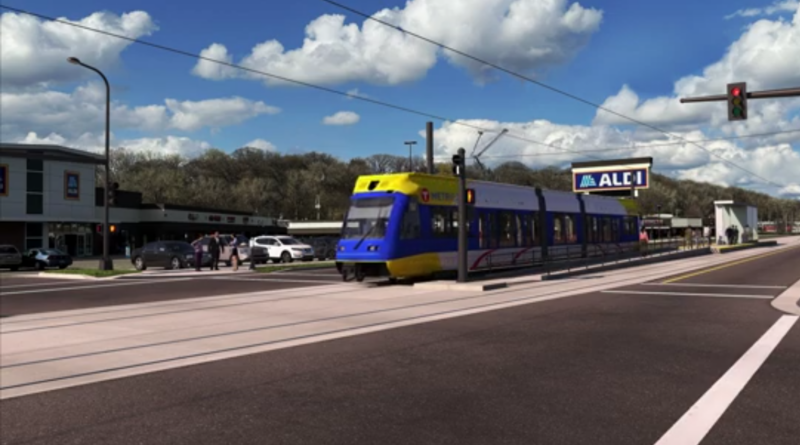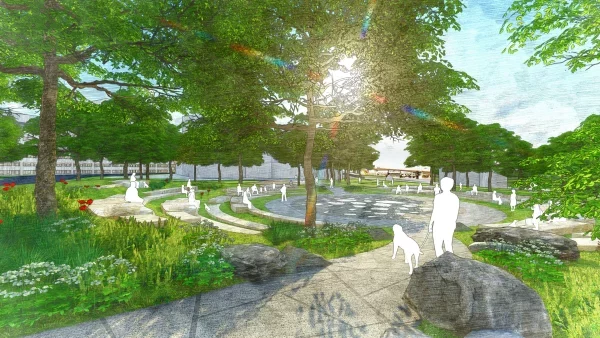Riverview planning rolls to next phase
The Riverview Corridor Policy Advisory Committee (PAC) approved exploring three prospective plans for enhanced transit connections along West 7th on February 29.
All three options, which would connect Union Depot to MSP International Airport along West 7th and Highway 5 and replace the existing route 54, will be rolled out over the spring and summer in the neighborhood by Ramsey County staff to receive public feedback.
Three Options
Project staff finalized presenting the three preferred options to the PAC on February 29, following up on their January 31 meeting. The three options include two modern streetcar options and an arterial bus rapid transit (ABRT) option.
The first streetcar option would feature a dedicated center-running right-of-way along 20 stops from Fort Snelling all the way to downtown. At Fort Snelling, it would connect with existing Blue Line tracks to connect to the airport and Mall of America.
Option two is planned to have the same alignment with dedicated right–of-way up until approximately Victoria St. where it would then be in maxed traffic, with stops located at the curbside rather than at stations in the center of the street. This option would also add two additional stops at Jefferson and Smith Avenues.
Both options would run along Kellogg through downtown before terminating at Union Depot.
The third option being taken to the public is an ABRT option, which would be dedicated bus service through the corridor. With ABRT, buses only stop at stations along the route. Fares are paid at the stations in advance of boarding and buses dwell at the stops for less time, increasing the speed and reliability of the service.
For all three options, service would be every 10 minutes along the route for most of the day, dropping to every 30 minutes during late nights. Currently the route 54 runs every 15 minutes.
Ridership Estimates
Project planners are estimating that the two streetcar options will have roughly similar ridership by 2040, with an estimate of 11,600 and 11,200 riders daily, respectively. The ABRT option is projected to have significantly fewer riders, with an estimate of around 8,000 riders per day.
These numbers come with a fairly sizable caveat, however – the ridership estimates are based on pre-pandemic metrics. Since the pandemic, Metro Transit has seen drastic change in how riders are using their service, especially with more people working from home. They don’t yet have new data with which to create projections based on current trends.
Project planners expect to have updated ridership projections sometime this summer.
Travel Times
The two streetcar options are projected to take longer, end-to-end, than the current route 54 bus. Currently route 54 takes, on average, about 42 minutes eastbound and 43 minutes westbound between the airport to Union Depot.
Streetcar option one is projected to take a little more than 43 minutes eastbound and 44 minutes westbound. Streetcar option two is looking at a travel time of almost 45 minutes eastbound and about 45 minutes, 30 seconds westbound.
The proposed ABRT route has an estimated time of right around 40 minutes in either direction.
“End-to-end travel time is a little bit misleading in that not everyone is going to be taking this line end-to-end,” said PAC member Tyler Blackmon. “I think one of the reasons that the streetcar is much longer is that there’s a lot of other activity that’s happening with the streetcar once it gets into Bloomington, and for a lot of folks that are just taking it within St. Paul as they come downtown, that time difference may not be there. In fact, it actually might be quicker on the streetcar.”
Costs

Each of the three options comes with a hefty price tag attached, further complicated by what is and isn’t included in the estimates.
The two streetcar options are being estimated at roughly the same top-line cost, coming in at $2.1 and $2.12 billion in 2033 dollars, respectively, for construction and purchasing equipment. They also have another $34 million in operations costs.
The ABRT option is estimated to have a significantly lower cost at $121 million with another $16.8 million for operations in 2030 dollars for building stations and replacing the existing route 54 buses with new, all-electric units.
With that said, those top-line numbers aren’t exactly comparing apples to apples.
Major differences between the streetcar and ABRT options include a complete street reconstruction and bridge replacement included in the cost of the streetcar, with neither happening with the ABRT project.
Also not apparent is the 40% contingency built into the estimated cost of each proposal.
“The big thing that jumps out to me is the 40% contingency,” said Time Marino, a transit advocate from St. Paul. “If we take out that number, we are looking at $1.32 billion for rail, including the estimated amount for the reconstruction of 7th street, which is $272 million. That doesn’t include the cost we will eventually need to replace a 63 year old bridge on Highway 5.”
“I would rather see the estimate include the reconstruction,” said Blackmon, addressing the exclusion of street reconstruction from the ABRT costs. “I’ve lived in this area for a long time, and it very much is in need of reconstruction.”
“I was also curious about the capital cost for the two streetcar options being broken out,” said Russ Stark, the Chief Resilience Officer for the City of St. Paul. “I think the public would be interested in knowing that, and I would be interested in knowing, what is the cost of reconstructing the entire [Highway 5] bridge?”
The project team said they are working with MnDOT on anticipated costs for replacing the Highway 5 bridge and the reconstruction of West 7th and are hoping to have the information available for the public this summer.
Economic Impact

Project planners said that, despite the high price tag, either streetcar option would have a more significant long-term impact on economic development in the area.
Based on their analysis, they found that if either streetcar option were to be built, $843 million in real estate value would be created, including a projected 6,800 new residential units and 653,000 square feet of commercial space over 20 years in St. Paul alone.
They found building ABRT would have less impact on economic development in the corridor, creating about $336 million in real estate value and adding 5,100 new housing units and 494,000 square feet of commercial space, which is about 12% growth over what they are projecting if nothing were to be built.
Short-term, both options would hit residents and business owners in the area during construction.
Post construction, streetcar option one would have the biggest impacts on parking and access to local businesses, restricting crossing except at signalized intersections and removing all but 35 parking spaces in the corridor.
Streetcar option two and ABRT would retain much of the on-street parking and allow traffic to flow mostly as it does now along West 7th.
Mixed opinions
Residents along the corridor had far ranging opinions of the plans, which ranged from building a larger light rails system to not building anything at all.
“Under the current projections of ridership, neither streetcar option measures up to the cost and performance advantages of the so-called ‘best bus,’” said Jay Severance, a member of Citizen Advocates for Regional Transit (CART). “Unless the ridership is increased, I don’t think the streetcar should be considered.”
“I would definitely not be in favor of option one, that takes away most of the parking along West 7th,” said Paul Hardt, who is a member of the Fort Road Federation Board and serves on the Riverview Community Advisory Committee. “Parking along there is vital to the businesses as well as the residents. If the parking is taken away, I believe that alternatives need to be considered, including possibly some parking ramps.”
Marino said one of his biggest considerations in the cost is what funding sources are available for different aspects of the project.
“What can qualify for federal money? A reconstruction of West 7th street won’t qualify for federal money, so even if that is $200 million to pay for the project on the streetcar, versus paid outside of it, that could be a difference of 50-60%,” he said.
Joe Landsberger, another member of CART, said that he would like to see more information about impacts to the area during construction.
“I hope there will be additional information that has not been presented,” he said. “First, the costs of any implementation to West 7th businesses and their customers, This includes not only construction, but inconveniences to their customers.”
Mac-Groveland resident Adam Farley said, for him, economic development is key in any decision on which version of the project to move forward.
“Streetcar will increase investment and property values along west 7th to the tune of hundreds of millions of dollars,” he said. “This multiplier effect has been shown time and time again with real projects, the Green and Blue Lines, in our own backyard.”
What comes next?
Now that project planners have been given the green light by the PAC, they will be taking the concepts to the community.
They plan to begin outreach throughout the corridor this spring and summer to solicit feedback from those impacted by the proposals.
They will bring the feedback back to the PAC this fall, with the hopes that PAC members will be able to choose an option to move forward with.
Learn more:To learn more about the proposed options, including maps, animations, meeting materials and more, visit ramseycounty.us/residents/roads-transportation/transit-corridors-studies/riverview-corridor




